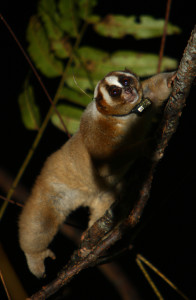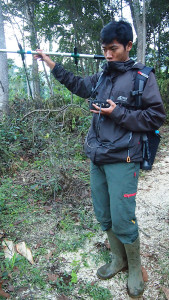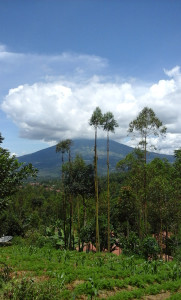“Ok, Azka the loris is definitely somewhere within this….2 km2 area”. Myself and Aconk, the tracker, were about a 45 minute hike up into the forest, in the dark, and suddenly we couldn’t get a signal on the loris we came to observe that night. Though we were unsure of what the problem was, we were certain that we couldn’t pin down the location to less than that area. With only headlamps and red filters to search, our hopes were slim of finding Azka that night.
Lorises are excellent at hiding and sometimes I think that they only let us watch them when they want to be watched. For starters, they enjoy sleeping in dense patches of bamboo where they are virtually impossible to see at times. I don’t blame them, it looks like a rather comfortable little fortress, but that doesn’t help us much. And so we sit, under a beautiful sky of stars, and wait. Wait for the loris to venture out of its cozy cocoon of bamboo and begin to explore the night.
I love these nights trekking through the maze of fields and forests in search of the ever elusive yet undeniably charming Javan slow loris. But as much as I enjoy the search, I recognize that our work would be much more difficult without the help of some essential equipment. Most critical perhaps being the tiny radio collars that each of “our” lorises wears. These collars transmit a loris’ location to help us find them. It’s amazing to see the lorises moving swiftly through dense vegetation as if the collar wasn’t even there.

In order to detect a certain loris’ unique frequency, our trackers carry receivers hooked up to large antennae which they expertly move to try and follow the signal as we navigate the steep terrain. It’s embarrassing to be gasping for breath and sweating as we hike through the forest and then turn to see a dry-faced tracker who’s carrying twice the gear, plus a massive antenna and not even out of breath. Oh, and he’s probably smoking a cigarette at the same time.

But here we were, unable to get a signal and unsure of what the problem was exactly. Maybe the collar was losing power. Maybe the antennae was malfunctioning, or the receiver. We could do tests on the equipment easily back at the LFP field station, but neither of us wanted to give up a night’s worth of observational data! So, we began to search…manually.
Using the bamboo patch that we knew the loris had used as a sleep site earlier that day as a starting point, we began to systematically search the trees around that area as it was only 19:00 and thus Azka most likely only left the sleep site an hour ago, no more.
I didn’t realize how spoiled I had been until this moment; having a perfectly clear signal easily directing me to the very tree that a loris was in. I didn’t realize it, until it was taken away from me. So, we began scanning the trees, one by one. We began climbing into difficult to reach positions just so that we could be sure to have had a view of each part of each tree; to be sure that we hadn’t missed a spot!

And then I saw it, like a flash of fire in the night. Two glowing red circles moving slowly, calculatingly through a kayu putih tree only 15 metres from the sleep site. After a quick high five and a brief celebratory dance, we sat down and began our observations. And you know what? Those 5 hours of data felt more earned than any other shift I’ve had.
I have an enormous amount of respect for earlier conservationists and the incredible data that has been collected through hard work and perseverance. But I’m very thankful that we have this great technology and equipment now to make our work easier. Less energy spent on finding the loris means more energy spent on saving them!
- Sharon McCabe, Field Station Coordinator
